The Potential of Games - PowerPoint PPT Presentation
1 / 30
Title:
The Potential of Games
Description:
UCLA Graduate School of Education & Information Studies ... Enjoyment of a game/sim. is linked mental effort. Mental effort is linked to. task difficulty ... – PowerPoint PPT presentation
Number of Views:29
Avg rating:3.0/5.0
Title: The Potential of Games
1
The Potential ofGames Simulationsfor Learning
and Assessment
- Richard Wainess wainess_at_cse.ucla.edu
- Presented Monday, January 22, 2007 at the 2007
CRESST Conference
2
Overview
- Do games simulations foster learning?
- Issues affecting learning from games
simulations - Assessments using games simulations
- Embedding instructional methods into games
simulations - The bottom line
3
Do games and simulations foster learning?
4
The promise of game/sim-based learning
- General belief is games simulations improve
instruction - Provide complex and diverse approaches to
learning - Provide learner control
- Can address both cognitive and affective needs
- Motivate learners
5
What the evidence shows
- Positive outcomes?
- Numerous knowledge outcomes are attributed to
games and simulations - Studies also warn about anecdotal and descriptive
evidence (Leemkuil et al., 2003 Wolfe, 1997) - Generalizable skills outcomes have been
cited(Day et al. 2001 Green Bavelier, 2003
Greenfield et al., 1994) - Negative or null outcomes?
- Reviews and meta-analyses cite mixed or negative
reviews(Dekkers Donatti, 1981 Druckman, 1995) - Positive attitude toward games (i.e., motivation)
doesnt necessarily equal learning(Brougere,
1999 Salas et al., 1998 Salomon, 1984)
6
What the evidence shows (contd)
- So, do games simulationsfoster learning?
NO!!!!
- Learning is related to Instructional Methods, not
media (games/simulations, book, lectures,
etc.)(de Jong van Joolingen, 1998 Garris et
al., 2002 Gredler, 1996 Leemkuil et al., 2003
Thiagarajan, 1998)
7
Implied model of games simulations
based on erroneous and/or unsupported research
conclusions
Games and simulations
Increased Learning
8
True model of games simulations
based on empirical evidence
Games and simulations
Studying
Prior Knowl.
Student Attitude
Teacher Training
Teacher Attitude
Student Ability
Instructional Components
Increased Learning?
9
Issues affecting learningfrom games and
simulations
10
Cognitive load
- burden placed on our working memory
- Affected by instructional components
- Number and nature of elements needing processing
(Cooper, 1998 Paas et al., 2003) - Message complexity, stimulus features(Daniels
Moore, 2000) - Particular to computer media interactivity
- Additional media-related cognitive demands
(Daniels Moore, 2000) - Level of learner control and autonomy(Dias,
Gomes, Correia, 1999)
11
Task difficulty
- Relationship of taskdifficulty to mental
effortis an inverted U(Clark, 1999 Malone
Lepper, 1987) - Too easy player gets bored
- Too hard player disengages
- Optimal cognitive load neither too hard nor too
easy
12
Sources of cognitive load
- Intrinsic Cognitive Load
- Germane Cognitive Load
- Extraneous Cognitive Load
- Learner Control
13
Sources of cognitive load
- Intrinsic Cognitive Load
- Load incurred by the to-be-learned
material(Brunken et al., 2003 Paas et al.,
2003) - (i.e., metacognition, forming schema, chunking,
automating) - Germane Cognitive Load
- Cognitive load imposed by instruction methods
and strategies required to process intrinsic
load(Renkl Atkinson, 2003) - (e.g., instruction, examples, reading, searching,
problem solving, interface elements)
14
Sources of cognitive load
- Extraneous Cognitive Load
- Imposed by an unnecessary stimuli (e.g.,
interface artwork, extraneous sounds)(Brunken et
al. 2003) - Seductive details (Mayer et al., 2001 Schraw,
1998) - Learner Control
- Pacing navigation(Barab et al., 1999 Cutmore
et al., 2000) - Metacognitive processes(Clark, 2003 Daniels
Moore, 2000 Dillon Gabbard, 1998) - Goal setting and planning, monitoring, selecting,
organizing, etc.)
15
Issues pertaining to games
- Extraneous details, split attention, learner
control
Tom Clancys Ghost Recon (Red Storm
Entertainment, 2002)
16
Issues pertaining to simulations
Extraneous seductive details, split attention,
learner control (cognitive load issues)
17
Issues pertaining to simulations
Experiential/Discovery-based Learning(metacogniti
ve and cognitive load issues)
Developed by the University of Southern
Californias Center for Cognitive Technology
(USC/CCT) using iRidesAuthor
18
Whats bad about games/sims?
- Extraneous and Seductive details
- Learner Control
- Mindless manipulation
- Potential for unguided learning
19
Whats good about games/sims?
- Authentic tasks
- Personalization
- Presence/immersion
- Motivation(and persistence)
20
What game/sim elements are detrimental?
- Rich, engaging content
- Immersive environments
- Impressive sound tracks
- Spectacular effects
- Compelling fantasy
- Gives learner control
- Can promote mindlessmanipulation
21
What game/sim elements are beneficial?
- Rich, engaging content?
- Immersive environments?
- Impressive sound tracks?
- Spectacular effects?
- Compelling fantasy?
- Gives learner control?
- Opportunity to experiment?
- Potential for adaptive learning
22
Assessment usinggames and simulations
23
Computer-based assessments
- Requirements
- Ability of computer to assess and report
performance - Ability of computer to use outcomes to adapt
learning - Ability to assess meaningful learning
- Applying knowledge and skills
- Authentic task performance
24
Computer-based assessments (contd)
- Examples
- Retention assessments(assess memory)
- Fill-in-the-blank
- Knowledge maps
- Performance based assessments(assess problem
solving, decision-making) - Knowledge maps
- Fill-in-the-blank
- Process maps
- Authentic tasks
25
Embedding assessments
- Pre-assessments(diagnostic assessment)
- Adaptive instruction
- Assess learning gains
- In-course assessments(formative assessment)
- Signaling/Priming/Cueing
- Feedback/Monitoring
- Authentic tasks
- Post-assessments(summative assessment)
- Assess learning outcomes
- Provide predictions of future performance
(transfer)
Developed by the University of Southern
CaliforniasCenter for Cognitive Technology
(USC/CCT) using iRidesAuthor
26
EmbeddingInstructional Methods intoGames and
Simulations
27
Embedded Guidance
- Instruction
- Worked examples
- Practice opportunities
- With goals
- Signaling/cueing
- Other learning scaffolds(instructional
methods/strategies)
Developed by the University of Southern
CaliforniasCenter for Cognitive Technology
(USC/CCT) using iRidesAuthor
28
The bottom line
29
The bottom line
- Can we learn from games and simulations?
YESWith proper instructional methods
Can games and simulations provideeffective
assessments?
YESParticularly if they exploit the capabilities
of computers
30
(No Transcript)































